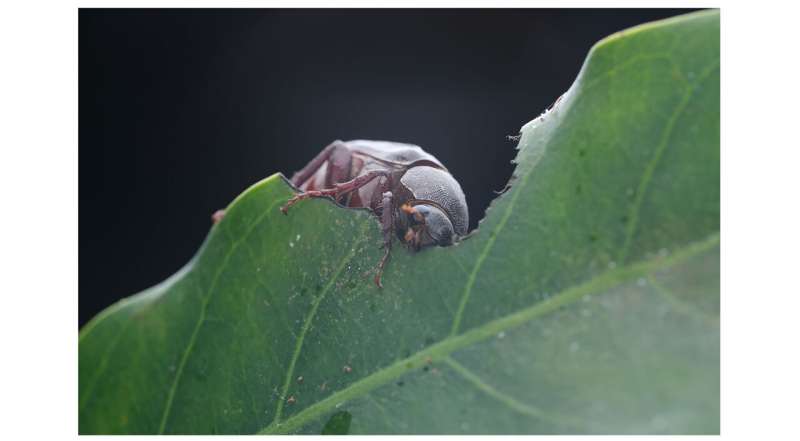This article has been reviewed according to Science X's editorial process and policies. Editors have highlighted the following attributes while ensuring the content's credibility:
fact-checked
peer-reviewed publication
trusted source
proofread
For this beetle, 'date night' comes every other day: The 48-hour cycle of the large black chafer beetle

Life on Earth runs on a 24-hour cycle as the planet turns. Animals and plants have built-in circadian clocks that synchronize metabolism and behavior to this daily cycle. But one beetle is out of sync with the rest of nature.
A new study, published Jan. 18 in Current Biology, looks at a beetle with a unique 48-hour cycle. The large black chafer beetle, Holotrichia parallela, is an agricultural pest in Asia. Every other night, the female beetles emerge from the soil, climb up a host plant and release pheromones to attract males.
This mating behavior by the female beetles is under the control of a 48-hour "circa-bi-dian" clock, for reasons that remain mysterious. A team led by Walter Leal, professor of molecular and cellular biology at the University of California, Davis, and Jiao Yin at the Chinese Academy of Agricultural Sciences, Beijing, wanted to know if the male beetles' ability to smell the females was also on a 48-hour clock.
Leal's lab at UC Davis studies chemical sensing in insects. Many insects, from moths to mosquitoes, use scent to attract a mate. Insects "smell" with their antennae, which contain specialized receptors that react to specific chemicals wafting through the air.
Following pheromones
The team's first step was to identify the gene in large black chafers for the receptor that reacts to the female pheromone, which has the seductive name L-isoleucine methyl ester, or LIME. The researchers initially cloned 14 candidate genes. A series of experiments led them to a gene called HparOR14 as the sex pheromone receptor—incidentally, the first such to be identified in a beetle species.
Having identified the receptor gene, they could measure levels of HparOR14 gene transcripts throughout the beetle's life and its activity over 48 hours. They found that on "date night," when females would be climbing plants to release scent, HparOR14 transcription was higher after dark. But receptor activity was low on the alternating days. (In a control experiment, the response to a chemical signal from damaged leaves, indicating food for the beetle, remained constant day after day.)
The results show that male chafers' ability to detect the female sex pheromone does run on a 48-hour, circabidian cycle that matches the female mating behavior.
Why and how large black chafers have these 48-hour cycles is unknown. Circadian (24-hour) clocks are synchronized by cues that change over a 24-hour cycle—the most obvious being the rising or setting of the sun. But there are no 48-hour cues in nature, so exactly how the circabidian cycles of large black chafers are set—including how males and females can synchronize with each other, so they all know which night is date night—is a mystery still to be solved.
"Twenty-four hour rhythms in physiology and behavior are commonly observed in organisms from bacteria to humans, but observations of 48-hour rhythms in nature are rare," said Professor Joanna Chiu, chair of the Department of Entomology and Nematology at UC Davis and an expert on circadian rhythms, who was not involved in the work. "This elegant study by Professor Leal and his collaborators has provided us with an in-depth description of how the circabidian rhythm of pheromone detection in this beetle is generated."
Additional authors on the study are: Yinliang Wang, Huanhuan Dong, Yafei Qu, Jianhui Qin, Kebin Li, Yazhong Cao and Shuai Zhang, Chinese Academy of Agricultural Sciences, Beijing; Yuxin Zhou and Bingzhong Ren, Northeast Normal University, Changchun, China; and Chen Luo, Beijing Academy of Agriculture and Forestry Sciences.
More information: Yinliang Wang et al, Circabidian rhythm of sex pheromone reception in a scarab beetle, Current Biology (2024). DOI: 10.1016/j.cub.2023.12.057
Journal information: Current Biology
Provided by UC Davis



















